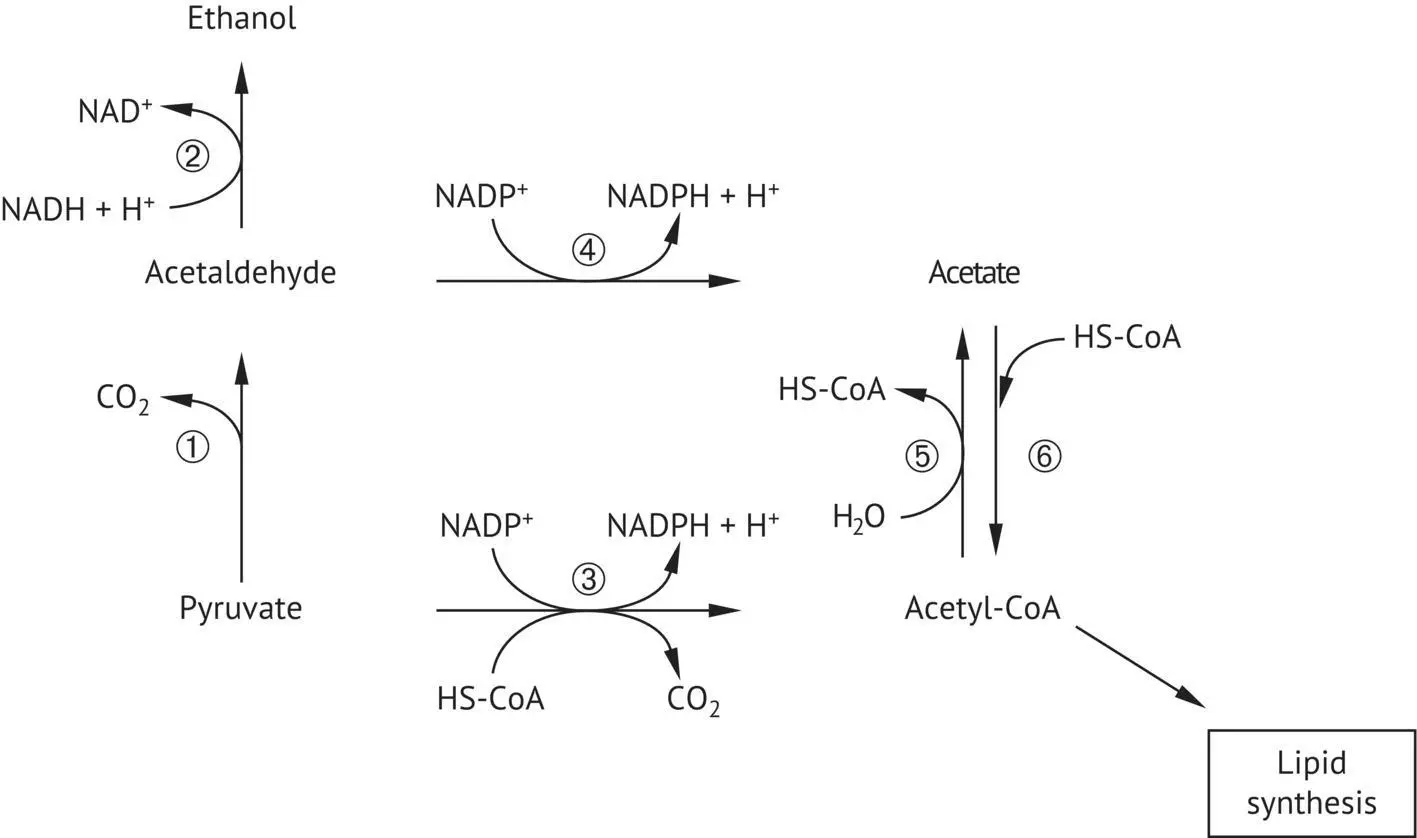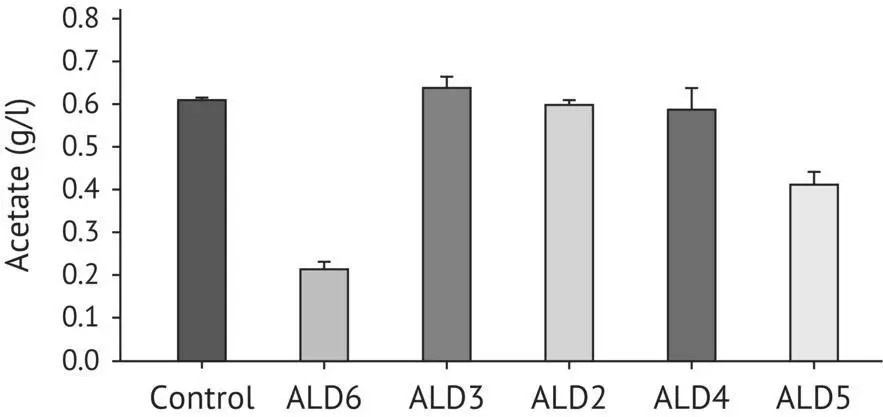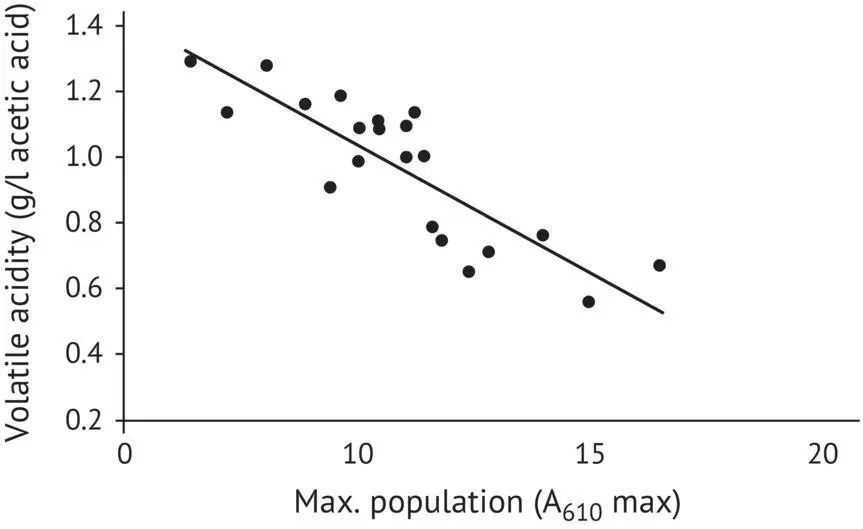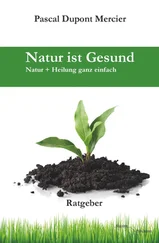
FIGURE 2.11 Acetic acid formation pathways in yeasts. 1, pyruvate decarboxylase; 2, alcohol dehydrogenase; 3, pyruvate dehydrogenase; 4, aldehyde dehydrogenase; 5, acetyl‐CoA hydrolase; 6, acetyl‐CoA synthetase.
The acetaldehyde dehydrogenase in S. cerevisiae has five isoforms, three located in the cytosol ( Section 1.4.1) (Ald6p, Ald2p, and Ald3p) and the remaining two (Ald4p and Ald5p) in the mitochondria ( Section 1.4.3). These enzymes differ by their specific use of the NAD +or NADP +cofactor ( Table 2.2).
Remize et al . (2000) and Blondin et al . (2002) studied the impact of the deletion of each gene and demonstrated that the NADP‐dependent cytoplasmic isoform coded by ALD6 played a major role in the formation of acetic acid during the fermentation of dry wines, while the ALD5 mitochondrial isoform was also involved, but to a lesser extent ( Figure 2.12).
TABLE 2.2 Isoforms of Acetaldehyde Dehydrogenase in S. cerevisiae (NavarroAvino et al., 1999)
| Chromosome |
Gene |
Location |
Cofactor |
| XIII |
ALD2 |
Cytosol |
NAD + |
| XIII |
ALD3 |
Cytosol |
NAD + |
| XV |
ALD4 |
Mitochondria |
NAD +and NADP + |
| V |
ALD5 |
Mitochondria |
NADP + |
| XVI |
ALD6 |
Cytosol |
NADP + |
Practical winemaking conditions likely to lead to abnormally high acetic acid production by S. cerevisiae are well known. As is the case with glycerol formation, acetic acid production is closely dependent on the initial sugar level of the must, independent of the quantity of sugars fermented ( Table 2.3). The higher the sugar content of the must, the more acetic acid (and glycerol) the yeast produces during fermentation. This is due to the yeast's mechanism for adapting to a medium with a high sugar concentration: S. cerevisiae increases its intracellular accumulation of glycerol to counterbalance the osmotic pressure of the medium (Blomberg and Alder, 1992). This regulation mechanism is controlled by a cascade of signal transmissions leading to an increase in the transcription level of genes involved in the production of glycerol ( GPD1 ), but also of acetate ( ALD2 , ALD3 , and ALD4 ) (Attfield et al ., 2000; Erasmus et al ., 2003; Pigeau and Inglis, 2005). Acetate formation plays an important physiological role in the intracellular redox equilibrium by regenerating reduced equivalents of NADH. Thus, it is clear that an increase in acetate production is inherent to the fermentation of high‐sugar musts. However, Bely et al . (2003) demonstrated that it was possible to reduce acetate production by supplying more NADH to the redox equilibrium process. This may be done indirectly by stimulating biomass formation, which generates an excess of NADH during amino acid synthesis (Bakker et al ., 2001). Assimilable nitrogen in the must plays a key role in this stimulation process. Thus, in high‐sugar musts, acetate production is inversely correlated with the maximum cell population ( Figure 2.13), which is, in turn, related to the assimilable nitrogen content of the must. It is strongly recommended to monitor the assimilable nitrogen content of botrytized musts and to supplement them with ammonium sulfate, if necessary. The optimum assimilable nitrogen concentration in this type of must to minimize acetic acid production is approximately 190 mg/l ( Figure 2.14). The best time for adding nitrogen supplements is at the very beginning of fermentation, as later additions are less effective and may even increase acetate production. Indeed, in view of the unpredictable increase in acetic acid production that sometimes occurred in botrytized musts supplemented with ammonium sulfate, many enologists had given up the practice entirely. It is now known that, provided the supplement is added at the very beginning of fermentation, adjusting the assimilable nitrogen content to the optimum level (190 mg/l) always minimizes acetic acid production in botrytized wines. Furthermore, Bely et al . (2005) demonstrated that direct inoculation with industrial preparations of active dry yeast leads to greater acetate production than does a yeast starter with a preculture period of 24 hours in a botrytized grape must diluted by half. This preculture period enables S. cerevisiae to adapt to the osmotic stress. Bely et al . (2008) showed that the species Torulaspora delbrueckii , which is a highly osmotolerant yeast, can be used in combination with S. cerevisiae to minimize acetic acid production during the making of wines from botrytized grapes.

FIGURE 2.12 Acetate production by strains of S. cerevisiae (V5) following deletion of different gene coding for isoforms of acetaldehyde dehydrogenase (Blondin et al ., 2002).
TABLE 2.3 Effect of Initial Sugar Concentration of the Must on the Formation of Secondary Products of the Fermentation (Lafon‐Lafourcade, 1983)
| Initialsugar (g/l) |
Fermentedsugar (g/l) |
Secondary products |
| Aceticacid (g/l) |
Glycerol(g/l) |
Succinicacid (g/l) |
| 224 |
211 |
0.26 |
4.77 |
0.26 |
| 268 |
226 |
0.45 |
5.33 |
0.25 |
| 318 |
211 |
0.62 |
5.70 |
0.26 |
| 324 |
179 |
0.84 |
5.95 |
0.26 |
| 348 |
152 |
1.12 |
7.09 |
0.28 |

FIGURE 2.13 Correlation between volatile acidity production and the maximum cell population in high‐sugar botrytized musts.

FIGURE 2.14 Effect of the yeast‐assimilable nitrogen content in must (with or without ammonium supplements) on the production of volatile acidity (initial sugar content: 350 g/l).
In wines made from botrytized grapes, certain substances in the must inhibit yeast growth (Volume 2, Section 3.7.2) and increase the production of acetic acid and glycerol during fermentation. Botrytis cinerea secretes these “botryticine” substances (Ribéreau‐Gayon et al ., 1952, 1979). Fractional precipitation with ethanol partially purifies these compounds from must and culture media of B. cinerea . These heat‐stable glycoproteins have molecular weights between 10,000 and 50,000. They are composed of a peptide (10%) and a carbohydrate part containing mostly mannose and galactose as well as some rhamnose and glucose (Dubourdieu, 1982). When added to healthy grape must, these compounds provoke an increase in glyceropyruvic fermentation and a more‐or‐less significant excretion of acetic acid at the end of fermentation ( Figure 2.15). The mode of action of these glycoproteins on yeasts has not yet been identified. The physiological state of yeast populations at the time of inoculation seems to play an important role in the fermentation of botrytized grape must. Commercial dry yeast preparations are much more sensitive to alcoholic fermentation inhibitors than yeast starters obtained by preculture in healthy grape must.
Читать дальше
















